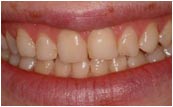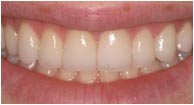Porcelain Veneers
Porcelain veneers are thin pieces of ceramics used to recreate the natural look of teeth, while also providing strength and resilience comparable to natural tooth enamel. It is often the material of choice for those looking to make slight position alterations, or to change tooth shape, size, and/or color without preparing the tooth for a full coverage restoration.
Visiting Engle Dentistry and asking about different ways to improve your smile is the first step in determining if veneers are the right option for you. They will discuss if there are other alternate solutions available as well. Communication with your dentist about what you want corrected is critical to optimize a successful result. Spend time clearly identifying what cosmetic improvements you are looking to achieve and be specific about exactly what you want to accomplish.
You’ll often hear people say that celebrities have veneers and this may seem like the best way to replicate picture-perfect teeth, but each mouth is different and certain criteria are required for veneers to produce the result that you are looking for.
Your dentist will most likely begin with a smile analysis so that they can begin determining what steps are necessary to achieve the smile you desire. They create a diagnostic mock-up that will allow them to properly plan your case and to “try on” veneers to show you if the final result is actually what you’re looking for. If necessary, your dentist may also decide to show you a photo of how your new smile will look. This can be accomplished using specialized software that allows for cosmetic imaging.
Porcelain laminate veneers consist of a compilation of thin ceramic layers which replace original tooth enamel and are attached to the natural prepared tooth with an adhesive layer. To begin preparing a tooth for a veneer, a very small amount of the original tooth enamel must be removed, usually less than a millimeter and in some cases slightly more. This is essential as it creates room for the porcelain veneer to be fabricated so that it can provide the look to the final restoration. This allows for the dentist to more accurately restore natural tooth esthetics and function while creating an even better appearance than the original tooth.
The adhesive bond between original tooth and porcelain veneer is critical as it not only provides the bonding of the restoration to the tooth but also aids in the final esthetic perfection. Having a strong adhesive bond is essential for correct veneer fixation to tooth structure. This adhesive layer is actually Light-sensitive resin that is placed between the original tooth and the veneer and then cured (hardened) using a special curing light.
Prepless Veneer


Traditional Porcelain Veneer




Porcelain veneers are a very successful option in many situations where the original tooth has developed poor color, shape, and contours. It is also a good choice for fractured teeth, gaps between teeth, and in some situations where the tooth position is compromised and there are minor bite-related problems. For some people, superficial stains do not respond well to tooth whitening or bleaching. In these situations, a porcelain veneer may be the best option.
Some patients are looking for an alternative to traditional dental veneers or bonding, but be aware that this treatment option is not appropriate for everyone.
Just as with porcelain veneers, "no-prep" or minimal preparation veneers— so called because they typically don't require the dentist to remove as much tooth material—are bonded to the front surface of your teeth. Often, the placement of no-prep veneers can be done more quickly and with less discomfort than traditional veneers.
Our specialists will let you know if you are a good candidate for minimal preparation or “no-prep” veneers and if this option makes a sensible treatment plan. Since veneers are individually sculpted for each patient, it is nearly impossible to tell the difference between a veneer and a natural tooth when using the proper laboratories. Unlike natural teeth, custom-made veneers resist coffee and tea stains, and cigarette smoke because they are made of high-tech pressed ceramic materials.
With veneers—as opposed to crowns—your natural teeth remain largely intact with only a minimal amount being altered to fit the veneer. For teeth that resist whitening, veneers can make even the darkest teeth appear more natural and even up to bright white. Dentists may also recommend veneers to quickly fix minor twists, overlaps, and small gaps.
Because a portion of the original tooth enamel is reduced, a veneer is not considered a reversible treatment. Although adjustments and new veneers can be made over time, you can never reliably return to the original condition of the tooth. Creating porcelain veneers requires some laboratory time, so expect at least a few weeks before they’re ready to be applied.
After the porcelain veneers are attached you will probably have some sensitivity to hot and cold temperatures due to the removal of that thin layer of enamel. This typically disappears within a few days and is significantly reduced with some of the newer adhesive materials. In a healthy mouth that is properly treated with porcelain veneers—and where destructive forces are minimized or eliminated—a patient should feel comfortable to use their porcelain veneers like their own natural teeth. Although they’re very strong, veneers are considered brittle especially before attached to the natural tooth. You should avoid the same excessive stresses you would avoid with non-veneered teeth: don’t bite your fingernails, chew ice, or open beer bottles as this will increase the chance of popping a veneer off!
Maintaining porcelain veneers is actually quite simple: Treat them as you would your original teeth, with routine brushing and flossing and regular hygiene visits to your dentist. Using non-abrasive fluoride toothpaste will typically be suggested by your dental professional. Due to the potential ceramic damaging chemical properties of Stanneos Fluoride, please make sure that your tooth paste does not this type of fluoride.
One week after your veneers are placed, you will be required to return to the office for a follow-up visit and evaluation so the dentist can see how your mouth is reacting to the veneers. Even if you feel the veneers are a success, this appointment is vital to ensure your future oral health.
If you have a habit of grinding or clenching your teeth at night, your dentist may fit you with a bite guard appliance so that you do not damage your veneers.
Please consider regular professional maintenance because porcelain veneers should be cleaned and treated like your natural teeth. Oftentimes, a dental professional can identify if there are any signs of wear or failure of the restoration prior to an embarrassing situation.
